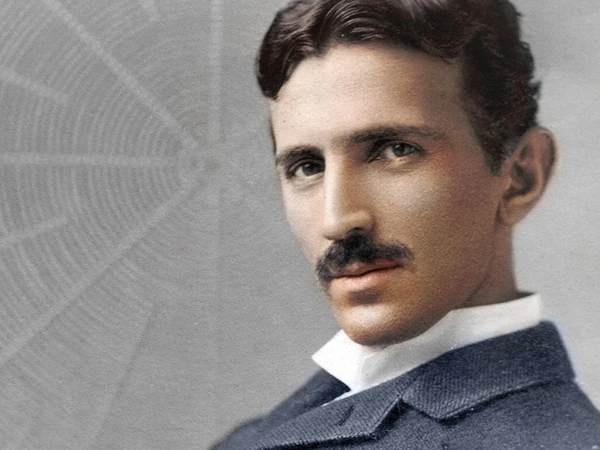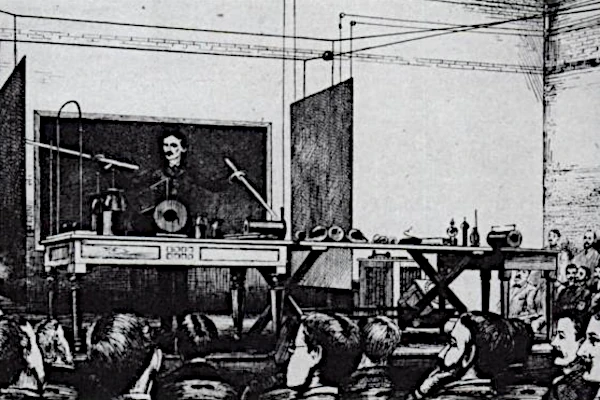
Nikola Tesla (1856-1943) was an engineer, inventor, and physicist of Serbian origin whose work shaped modern applied physics. He is the creator of "alternating current," three-phase current, and the induction motor. Born in Smiljan (present-day Croatia), Tesla studied physics and mathematics at the University of Graz before working in telegraphy and electrical engineering. His visionary mind led him to conceptualize a world of wireless energy, anticipating field physics and radio waves.
In 1882, Tesla discovered the principle of the rotating magnetic field. By using two sinusoidal currents in quadrature, he achieved rotation without a mechanical commutator. The induction motor is based on this principle: the magnetic field produced in the stator induces a current in the rotor, generating electromagnetic torque.
In 1888, the Westinghouse Company purchased his patents for polyphase motors. This collaboration enabled large-scale electrification using alternating current, in direct competition with Thomas Edison (1847-1931), a staunch advocate of direct current. This "War of the Currents" ended with the victory of the Tesla-Westinghouse system, which allowed electricity to be distributed over long distances with superior efficiency.
Between 1890 and 1900, Tesla conducted spectacular experiments on resonance and wireless energy transmission. In his Colorado Springs laboratory, he built a Tesla coil, capable of generating voltages exceeding one million volts. His goal: to create a global network of energy and information, a kind of early Internet. The high-frequency oscillations, comparable to those described by James Clerk Maxwell (1831-1879), demonstrated the continuity between electric and magnetic fields.
N.B.:
The Tesla coil functions as a loosely coupled transformer. Its efficiency is limited by dielectric losses and wire resistance, but the voltage achieved can exceed 5 MV.
Isolated in his later years, Tesla continued to publish groundbreaking ideas on directed energy beams and terrestrial standing waves. He died in New York in 1943, in poverty, but his scientific legacy is immense: asynchronous motors, wireless transmission, and the foundations of modern electromagnetic field physics.
| Year | Invention / Discovery | Physical Principle | Impact or Application |
|---|---|---|---|
| 1882 | Rotating Magnetic Field | Superposition of two sinusoidal fields in quadrature | Basis of the induction motor |
| 1888 | Induction Motor | Electromagnetic induction \(\, \text{EMF} = - \frac{d\Phi}{dt} \,\) | Efficient conversion of electrical energy into mechanical energy |
| 1891 | Tesla Coil | Resonance in an LC circuit | Production of high voltages and radio wave studies |
| 1899 | Wireless Transmission | Propagation of electromagnetic waves | Precursor to radio and radar technologies |
Reference: Nikola Tesla, My Inventions, Electrical Experimenter (1919).

In 1893, at the Chicago World's Fair, Nikola Tesla (1856-1943) performed a spectacular demonstration: he lit a discharge lamp without any power wires. The bulb contained a rare gas (mainly argon), and the emitted light came from the corona discharge produced by an alternating electromagnetic field.
Tesla placed the tube near a high-frequency resonant circuit, powered by a coil of his invention. Under the effect of the electric field \(E(t) = E_0 \sin(\omega t)\), the free electrons in the gas were accelerated, causing collisions and thus visible light emission. The experiment demonstrated for the first time the possibility of energy transfer without contact or conductor, foreshadowing modern wireless charging technologies.
The phenomenon relied on the resonance between the excitation frequency and the tube's capacitance, creating sufficient electrostatic coupling to ionize the gas. Tesla thus showed that light could be produced solely by a varying electric field, without direct conduction.
N.B.:
The oscillating field generated by the Tesla coil locally exceeded 10 kV/cm. At these intensities, the electron density \(n_e\) of the gas was sufficient to sustain continuous emission. This principle is now used in RF discharges, essential in microelectronics and plasma physics.